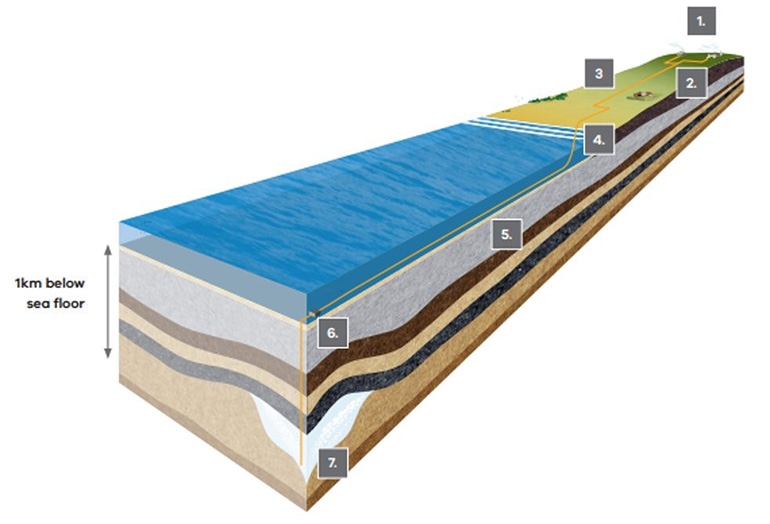About the CarbonNet Project
The CarbonNet Project, located in Gippsland, is one of the most technically advanced multi‑user Carbon Capture and Storage (CCS) hubs under development in Australia. Funded by the Victorian and Australian Governments and established in 2009, CarbonNet is recognised as one of many solutions for reducing carbon dioxide (CO2) emissions from the atmosphere.
The purpose of the project is to establish a commercial‑scale CCS network in Gippsland that will enable new and existing decarbonised industries to contribute to Victoria’s 2035 interim emissions reduction target and a net zero emissions outcome by 2045. Delivery of CarbonNet will be beneficial for the Gippsland region where jobs and investment will occur as a direct result of this project.
There is potential for CarbonNet to transport and store up to six million tonnes of CO2 per year at the initial Pelican site once fully operational. It is expected that it will take 2-3 years to build up to this level once CarbonNet is commissioned. There is further capacity available to scale-up storage once the Kookaburra site comes online.
The pipeline
CarbonNet plans to build a 100km pipeline from Loy Yang to Golden Beach which will enable multiple CO2 industrial capture projects, based in the Latrobe Valley, to share CO2 transportation infrastructure.
The pipeline will consist of approximately 80km of buried onshore pipeline and a further 20km (approximate) of offshore pipeline, reaching two drill centres located at CarbonNet’s Pelican site.
Pelican
The Pelican storage site is located off Golden Beach in the Gippsland Basin approximately 1.5km beneath the seabed. The site has at least 168 million tonnes capacity and can take up to 6 million tonnes of CO2 per year.
Pelican is a very large, dome shaped geological structure that has many rock layers.
The porous layers of sandstone deep under the surface act like a sponge to store the CO2, while layers of shale and coal form the barriers to trap the CO2 – the same way oil and gas has been trapped in Bass Strait naturally for millions of years.
Project timeline
Should the CarbonNet Project proceed past Final Investment Decision (FID), the proposed operational timeline of the project is:
- FID in 2024
- Project operational late 2020s.
Project progress
CarbonNet has completed extensive investigations which have been subject to independent review and certification, including detailed modelling of potential CO2 storage sites in Bass Strait.
The project is currently in Stage Three - Project Development and Commercial Establishment.
- Regulatory approvals will commence - Environment Effects Statement referral (Vic) and Environment Protection and Biodiversity. Conservation referral.
- Front-Engineering Design (FEED) completed.
- Front-Engineering Design (FEED).
- Pipeline Consultation Plan approved.
- Preparation for regulatory approvals, FEED and DoS.
- Offshore Appraisal Well and analysis of geology.
- Regulatory and environmental approvals achieved, and ongoing.
- Stakeholder and community engagement taking place and ongoing.
- Request for Industry Submissions (RFIS).
- Geophysical and Geotechnical surveys conducted in preparation of the drilling the Offshore Appraisal Well.
- Extensive stakeholder and community engagement ongoing.
- A marine seismic survey in February 2018 provided additional geological information about Pelican.
- The Victorian and Australian Governments agreed to progress CarbonNet to Stage 3 – Project Development and Commercial Establishment.
The Pelican concept

The above image is representative of the Earth’s layers with multiple levels of rock. It shows an example of a reservoir used to store carbon dioxide 1km below the Earth’s surface.
The surface layer is split into an onshore component and an offshore component. The onshore component displays an illustration of a capture site, connection point and an onshore pipeline. The offshore component displays an illustration of an offshore pipeline and a geological storage reservoir.
Multiple elements are labelled which match up with the described elements in the Projects elements description table.
Project elements description
| Label Number | Project Element | Description |
|---|---|---|
| 1. | Customer Capture Sites (Not CarbonNet owned or operated) | Customer capture sites will provide captured and compressed CO2 to CarbonNet for transportation and storage at Pelican. Potential industries include, but are not limited to, hydrogen, fertiliser and bioenergy. |
| 2. | Gateway Connection Point | A gateway connection point will be located at Loy Yang in the Latrobe Valley, enabling multiple planned or operating projects to connect into the CO2 transportation and storage network. Loy Yang is therefore the proposed start point for the CO2 transport pipeline. |
| 3. | Onshore Pipeline | Approximately 80km of 400mm* pipeline will run from Loy Yang to the shoreline crossing at Golden Beach. *Diameter to be confirmed during Front End Engineering Design. |
| 4. | Shoreline Crossing | The pipeline will cross the shoreline likely using a horizontal directional drilling (or similar) technique, to avoid direct impacts on sensitive coastal features. The pipeline will emerge 1km offshore. |
| 5. | Offshore Pipeline | Approximately 20km of pipeline will be laid directly on the seafloor, depending on the local design requirements, to the subsea injection location at Pelican. |
| 6. | Offshore injection and monitoring wells | It is envisaged that Pelican will include up to six injection wells (including monitoring systems) distributed across two drill centres, with possible additional monitoring wells. |
| 7. | Geological CO2 storage reservoir – Pelican | Capacity of up to six Mtpa over 30 years and storage of compressed CO2 within the Pelican structure modelled for permanent containment. |
Page last updated: 15 March 2024
